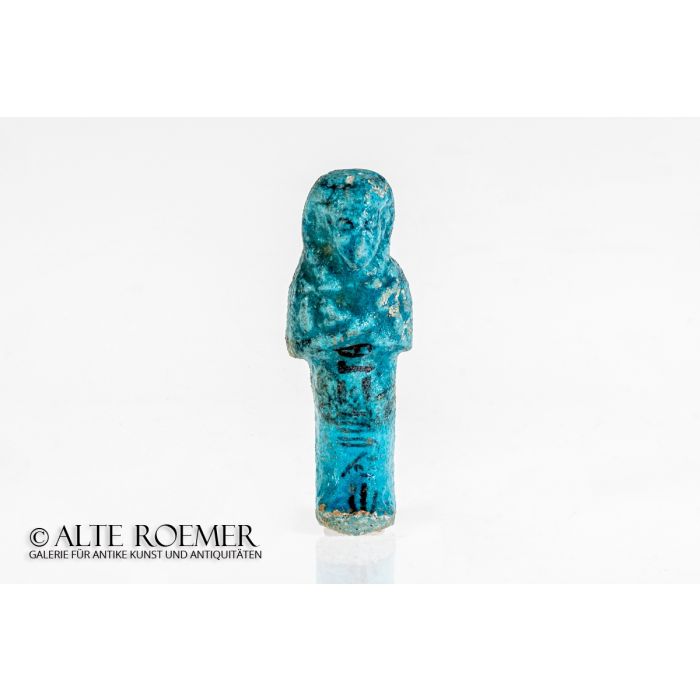Shabti for Ly-hotep-em-mut
Price: on request
Sold
Object number
AR2687
| Object: |
Egyptian shabti for Ly-hotep-em-mut
|
| Material: |
Fayence with black paint.
|
| Period: |
Third Intermediate Period of Ancient Egypt, 22. dynasty, approx. 945 BC to 715 BC. |
| Description: |
Egyptian funerary statuette with a mummy shaped body. Details are summarily modelled. The shabti wears a tripartit wig secured by a fillet with rear ties. Eyes outlined and modelled and emphasized with black. Holds thick unpainted pair of modelled hoes and bag with diagonal hatching at back added in black. A vertical column of hieroglyphs on the front reads as follows. wsir ly-htp-m-mwt-hrw which translates The Osiris, ly-hotep-em-Mut, justified. The name means literally "the one who comes peacefully with Mut", in which Mut is the vulture goddess and consort of Amun. Also the spellings Ii-hotep-em-Mut and Yi-hetep-em-Mut for the name can be found in literature. |
| Dimensions: |
110mm height, 40mm width.
|
| Condition: |
Good condition. Surface slightly worn and small chips. Attractive accretions attest the age of the piece. Also the original black paint is in large parts still visible.
|
| Provenance: |
Acquired by us in 2019 from the German private collection of D. R. Acquired by him in 2019 from Hanson Auctioneers, London. From the estate of Julian Bird, London. Acquired into the collection of J. Bird in 2013 from the Dutch private collection of Herman Bowie. Previously with the Spanish dealer J. Bagot, Arqueologicia, Barcelona. Acquired by him from the Spanish private collection of J. M. Ortuondo, Bilbao. Acquired in the Ortuondo collection around 2000 from the British private collection of A. Szolin, Leicester. Previously with the Rolls-Royce family collection, Sir Henry Royce (1863 - 1933), Great Britain. In the notes on his detailed research of the piece Julian Bird remarks that shabtis of this owner are known from the famous excavation of James Quibell in 1896 in the Ramesseum. And indeed Quibell writes 1898 in his book "The Ramesseum" for the British School of Archeology, chapter IV, p. 9ff: "To this period of the XXIInd dynasty belong the greater part of the things found. Head-pieces from wooden coffins, scraps of cartonage, mummy cloths, beads and ushabtis were the daily staple of finds, and whenever those could be dated with certainty it was to the XXIInd dynasty that they belonged. " and "Of the tombs of this period more than two hundred were examined"However, the owner names mentioned in the same book by W. Spielberg do not include the name ly-hotep-em-Mut. According to the notes of J. Bird this shabti was published and exhibited on multiple occasions. Exhibitions: - Galicia, "Viva y Muerte en el Antiguo Egipto. Del Arte faraonico al Faro de Alejandro" (2005) - Logrono, "Herencias de Egipto. De las Dos Tierras al pais de la Reina de saba" (2006) - Roman museum in Oiasso, Irun, "Egipto. La Mirada Romantica" (2011) Publications: - Exhibition catalogue "Viva y Muerte en el Antiguo Egipto", p. 219-224. - Exhibition catalogue "Herencias de Egipto. De las Dos Tierras al pais de la Reina de saba", p. 258-263 |
| References: |
Cf. G. Janes, Shabtis, p. 63, no. 31. Cf. Shabti Collections 3, Rochdale, p. 46, no. 17. Cf. Shabti Collections 4, Stockport, p. 3, no. 3. |
| Literature: |
J. E. Quibell, The Ramesseum, in Egyptian Research Account 1896 (London, 1898).
|
| Authenticity: |
We unconditionally guarantee the authenticity of every artefact, all items are subject to our lifetime return policy on authenticity.
|


